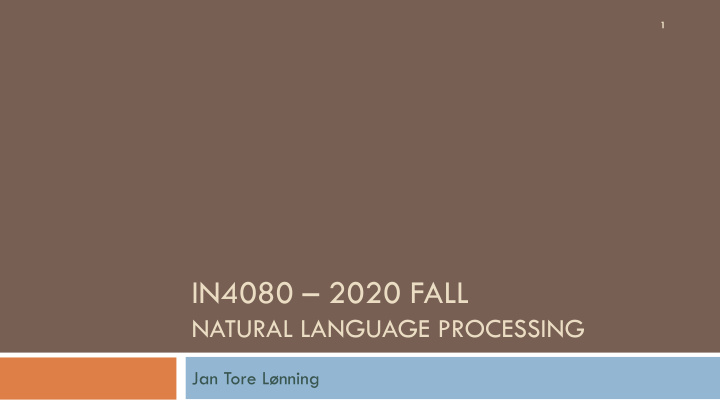



1 IN4080 – 2020 FALL NATURAL LANGUAGE PROCESSING Jan Tore Lønning
Today 2 Part 1: Course overview What is this course about? How will it be organized? Interactive zoom Part 2: ”Looking at data”: Descriptive statistics Some language data Video lectures
Name game 3 Computational Linguistics Traditional name, stresses interdisciplinarity Natural Language Processing Computer science/AI/NLP ”Natural language” a CS term Language Technology Newer term, emphasize applicability LT today is not SciFi (AI), but part of everyday app(lication)s The terms have different historical roots Today: NLP=Computational Linguistics, restricted to written language LT = NLP + speech (No speech in this course)
Megatrends 4 Natural Language Processing "Data science" Big data Artificial Intelligence AI (WWW) • Machine learning • Deep learning
5 Language technology: examples
1. Speech text 6
2. Machine translation 7
3. Dialogue systems 8
4. Sentiment analysis and opinion mining 9 Sentiment/opinion mining: Do consumers appreciate more sugar in the soda? Do (my core voters) like my last Twitter outburst? How will the stock prices Personalization: develop? Adds Is there a danger of a revolt in News country X?
5. Text analytics 10 Goal, example IBM's Watson Similarly in other domains: system: Oil & Gas Read medical papers + Legal domain records: Propose diagnoses Propose treatments +
6. NLP applications – more examples 11 Intelligence Surveillance: How does NSA manage to read all those e-mails? User content moderation Election influence
What? 12
What 13 https://www.uio.no/studier/emner/matnat/ifi/IN4080/index.html Follow steps in bottom-up data-driven text systems Learn to set-up and carry out experiments in NLP: Machine learning Evaluation in-depth knowledge of at least one application Dialogue system (October) "…in - depth knowledge of at least one [NLP] application…" In addition Ethics in NLP
Some steps when processing text 14 Split into sentences Obama says he didn't fear for 'democracy' when running against McCain, Romney. Tokenize (normalize) | Obama | says | he | did| not | fear | for | ‘ | democracy | ‘ | when | running | against | McCain | , | Romney | . Tag Obama_N says_V he_PN did_V not_ADV fear_V … Lemmatize Says_V say_V, did_V do_V, running_V run_V … Parsing (dependency) Coreference resolution Obama says he did not ….. Semantic relation detect. Fear(Obama, Democracy) Run_against(Obama, McCain),.. Negation detection … did not fear … Not(Fear(Obama, Democracy))
The two cultures (up to the 1980s) 15 Symbolic Stochastic 1956 Information theory, 1940s Sub-cultures Statistics AI (NLU) 1. Electrical engineering McCarthy, Minsky SHRDLU ('72) Formal Linguistics/Logic 2. Signal processing Chomsky automata, formal grammars + Logic in the 80s LFG, HPSG Discourse, pragmatics 3.
Trends the last 30 years 16 1990s: combining the cultures 2000s: methods from speech adopted More and more machine by NLP learning in NLP , at all levels division of labor between methods Examples and corpora stochastic components in symbolic Rethinking the curriculum and the models, e.g. statistical parsing order in which it is taught (larger) text corpora J&M, 2. ed, 2008 Jurafsky and Martin, SLP , 2000 Example: machine translation systems that are trained on earlier translated texts
Currently 17 2010s Deep learning ML with multi-layered Neural Networks Revolution, in particular for Image recognition Speech Entered into all parts of NLP Key: "Word embeddings"
DL and IN4080 18 Should we jump directly to The inner workings of Deep deep learning? learning in NLP is the topic in "IN5550 Neural Methods in We will (initially) focus on NLP“, spring 2021 simpler models. Most tasks are independent of learning algorithm, and can be easier understood using simpler models For several tasks, traditional ML is still compatible
NLP is based on 19 Computer Linguistics, science, languages programming NLP Machine Learning Statistics
Why statistics and probability in NLP? 20 1. “Choose the best” (=the most probable given the available information) bank (Eng.) can translate to b.o. bank or bredd in No. Which should we choose? What if we know the context is “ river bank ”? bank can be Verb or Noun, which tag should we choose? What if the context is they bank the money ? A sentence may be ambiguous: What is the most probable parse of the sentence?
Use of probabilities and statistics, ctd.: 21 2. In constructing models from examples (ML): What is the best model given these examples? 3. Evaluation: Model1 is performing slightly better than model 2 (78.4 vs. 73.2), can we conclude that model 1 is better? How large test corpus do we need?
How? 22
Syllabus (online) 23 Lectures, presentations put on the web Jurafsky and Martin, Speech and Language Processing, 3.ed. In progress, edition of Oct. 2019 Articles from the web In addition Some selections from S. Bird, E. Klein and E. Loper: Natural Language Processing with Python available on the web, python 3 ed. Probabilities and statistics (some book or) www.openintro.org/stat/textbook.php
Challenges for a master's course like this 24 You have different backgrounds: Some are familiar with some NLP from e.g. IN2110 Some are familiar with simple probabilities and statistics, some are not Some are familiar with Machine Learning Some are familiar with Language and linguistics For teaching: You might have heard some of it before You might experience a step learning curve on other parts For you: Concentrate on the parts with which you are less familiar
Schedule 25 Lectures: Mondays 10.15-12 3 mandatory assignments (oblig.s) Room Java (34 seats) Weeks 37, 40, 43 Screencasts distributed after lecture Written exam Lab sessions: Tuesdays 10.15-12 Wednesday 2 December Room: Fortress 3468, (18 seats) No screencast PadLet for QAs Booking system No Piazza or Slack (GDPR) Some sort of zoom-group
Tomorrow 26 Tutorial on probabilities Regular groups start 25.8 10.15 Fortress Sign up
Background knowledge 27 Please fill in: https://nettskjema.no/a/157223
Recommend
More recommend